You might not realize that neglecting simple maintenance tasks can lead to costly repairs down the line. To keep your motorcycle running smoothly, it's vital to develop a routine that addresses key components like oil changes, tire health, and brake systems. By staying proactive, you can enhance your bike's performance and longevity. So, what are the specific steps you should take to guarantee everything's in top shape? Let's explore some practical tips that could save you time and money on the road.
Key Takeaways
- Perform regular oil changes every 3,000 to 5,000 miles to ensure proper engine lubrication and reduce wear.
- Maintain optimal tire pressure and tread depth to enhance safety and handling on the road.
- Regularly inspect and replace brake pads and fluid to ensure effective stopping power and safety.
- Clean and lubricate the chain and sprockets to promote smooth performance and prevent premature wear.
Regular Oil Changes
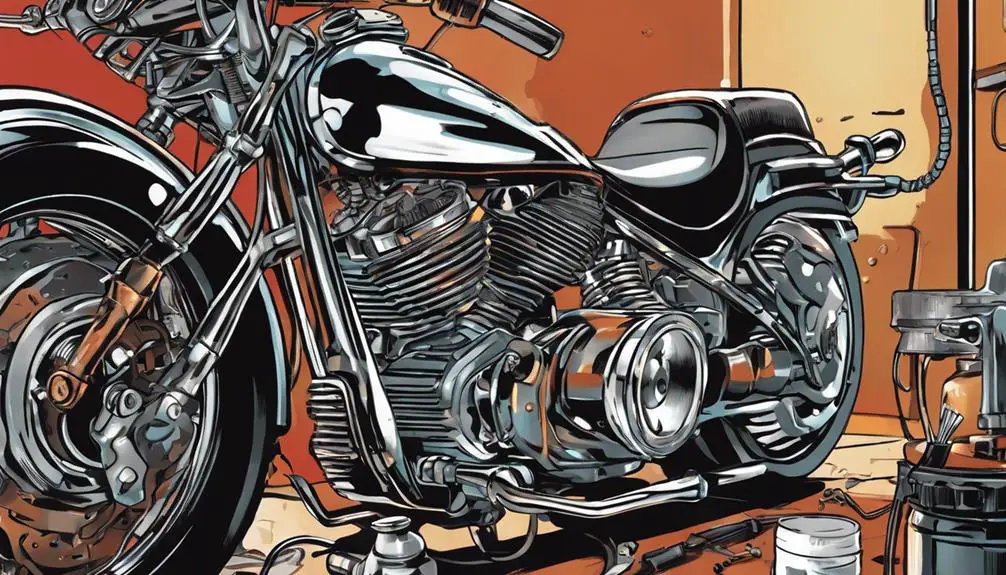
Regular oil changes are essential for keeping your motorcycle's engine running smoothly and efficiently. You mightn't think about it often, but that engine oil is the lifeblood of your ride. It lubricates the moving parts, reduces friction, and helps manage the heat generated during your adventures.
When you neglect those oil changes, you're risking not just engine performance but also your freedom on the open road.
You should check your owner's manual for the recommended oil change interval—usually every 3,000 to 5,000 miles, depending on your bike and the oil type. Don't just go by mileage, though; pay attention to how you ride. If you're pushing your motorcycle hard or riding in harsh conditions, you might need to change the oil sooner.
When you do change the oil, make sure to use the right type of oil. Synthetic oil can provide better protection and performance, particularly for high-performance engines.
Always remember to dispose of old oil responsibly; it's a small act that contributes to your community's well-being.
Prioritize regular oil changes, and you'll enjoy a smoother ride, more freedom, and peace of mind as you conquer the roads ahead.
Tire Maintenance Tips
Just like engine oil, your tires play a vital role in your motorcycle's performance and safety, so keeping them in good shape is key to enjoying your rides. Neglecting tire maintenance can lead to poor handling and increased risk on the road.
Here are some essential tips to guarantee your tires stay in top condition and keep your freedom alive:
- Check Tire Pressure: Regularly inspect your tire pressure. Under-inflated tires can lead to poor handling, while over-inflated tires wear out faster.
- Inspect Tread Depth: Keep an eye on the tread depth. Worn tires can compromise grip and increase stopping distances. Use the penny test or a tread depth gauge to assess wear.
- Look for Damage: Routinely examine your tires for cuts, cracks, or bulges. Any visible damage can jeopardize your safety, so replace damaged tires immediately.
- Rotate Tires: Rotate your tires periodically to guarantee even wear. This practice can extend tire life and enhance performance, keeping your ride smooth and exhilarating.
Brake System Checks
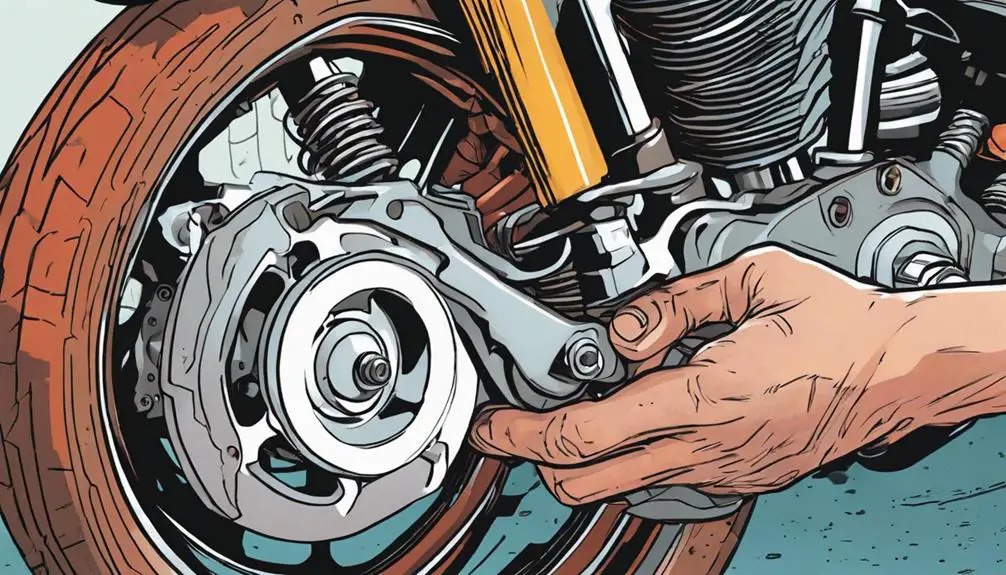
When it comes to your motorcycle's safety, regular brake system checks are essential.
You'll want to inspect your brake pads often and keep an eye on the fluid levels to guarantee everything's functioning properly.
Staying proactive in these areas can help you avoid potential issues down the road.
Inspect Brake Pads Regularly
Checking your brake pads frequently guarantees your motorcycle stays safe and responsive on the road. Your freedom on two wheels depends heavily on your ability to stop when needed.
Regular inspections give you confidence and control, allowing you to ride with peace of mind. Here are four essential tips to keep your brake system in top shape:
- Visual Inspection: Look for wear indicators or grooves on your brake pads. If they're worn down, it's time to replace them.
- Listen for Noises: Pay attention to any squeaking or grinding sounds when you brake. These can signal that your pads need immediate attention.
- Check for Vibration: If you feel vibrations in your handlebars during braking, your pads may be unevenly worn, affecting your stopping power.
- Monitor Brake Fluid: Although we're not diving into fluid levels here, a low brake fluid level can affect pad performance. Keep this in mind during your inspections.
Check Fluid Levels Frequently
Regularly monitoring your motorcycle's fluid levels is essential for maintaining ideal brake performance and guaranteeing your safety on the road. The brake fluid is a critical component; it transfers force from your hands to the brakes. If the fluid's low or contaminated, your brakes won't respond as they should, putting you at risk.
To check the brake fluid, locate the reservoir, typically found near the handlebars. Verify the level matches the manufacturer's recommended mark. If it's low, top it off with the appropriate fluid type—never mix different types. It's also important to inspect the fluid's color. If it's dark or murky, it's time for a change.
Don't overlook the importance of this task. Your freedom on the open road depends on the reliability of your brakes. Make it a habit to check your fluid levels regularly, ideally every month or before long rides.
Chain and Sprocket Care
To keep your motorcycle running smoothly, maintaining the chain and sprockets is vital for peak performance and safety. A well-cared-for chain and sprocket system not only enhances your ride but also helps you feel the freedom of the open road without fear of mechanical failure.
Here are some tips to keep your chain and sprockets in top shape:
- Regular Cleaning: Dirt and grime can wear down your chain and sprockets. Clean them regularly with a proper chain cleaner to remove debris and prevent rust.
- Proper Lubrication: Apply high-quality chain lubricant after cleaning. This guarantees smooth movement and reduces friction, extending the life of both the chain and sprockets.
- Check Tension: A correctly tensioned chain is essential. Too tight, and you risk damaging components; too loose, and it could come off while riding. Check the tension frequently.
- Inspect for Wear: Regularly inspect your chain and sprockets for signs of wear and tear. Replace them if you see significant damage to avoid compromising your ride.
Battery Maintenance
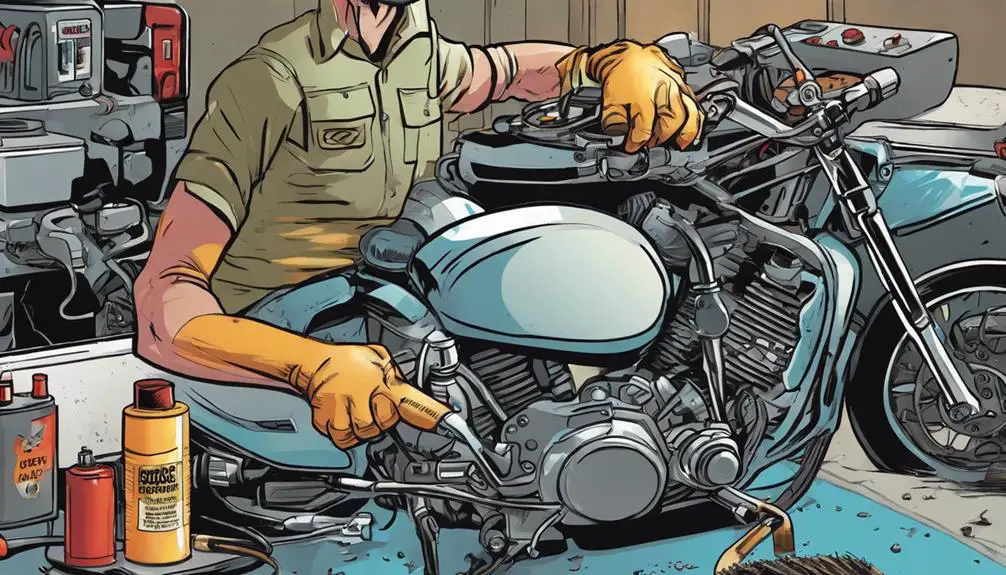
Maintaining your motorcycle's battery is just as important as caring for the chain and sprockets, as a healthy battery guarantees reliable starts and overall performance.
Start by checking the battery terminals regularly for corrosion. A simple cleaning with a mixture of baking soda and water can work wonders, ensuring a solid connection and preventing power loss.
Next, inspect the battery fluid levels if you have a traditional lead-acid battery. If it's low, top it off with distilled water to keep it functioning efficiently. Avoid overcharging; excessive heat can damage the battery, so be mindful of how long you leave it on the charger.
If you ride infrequently, consider investing in a trickle charger. This keeps the battery charged without overdoing it, especially during those long winter months.
Finally, always keep an eye on the battery's age. Most batteries last around three to five years, so if you're nearing that mark, plan for a replacement.
Embrace these practices, and you'll enjoy the freedom of the open road, confident that your motorcycle will always be ready to ride when you are.
Fuel System Inspection
When it comes to keeping your motorcycle running smoothly, a thorough fuel system inspection is essential.
You should check the fuel lines for any cracks or leaks and make sure they're securely connected.
Don't forget to clean the fuel injectors regularly to maintain peak performance.
Check Fuel Lines
Inspecting your fuel lines regularly is essential for preventing leaks and guaranteeing your motorcycle runs efficiently.
When you take the time to check them, you're not just keeping your ride smooth; you're embracing the freedom that comes with a well-maintained machine.
Here are four key points to focus on during your inspection:
- Look for Cracks or Wear: Examine the lines for any signs of deterioration. Cracks can lead to fuel leaks, which are dangerous and can ruin your ride.
- Check Connections: Verify all connections are secure. Loose fittings can cause fuel to escape, compromising your bike's performance.
- Inspect for Leaks: Keep an eye out for any fuel stains or dampness around the lines. A quick fix now can save you from a major headache later.
- Replace as Needed: Don't hesitate to replace worn or damaged lines. Investing in new fuel lines enhances safety and keeps your motorcycle running strong.
Clean Fuel Injectors
Cleaning your fuel injectors is essential for ensuring ideal engine performance and fuel efficiency. When your injectors get dirty, they can't deliver fuel properly, leading to engine misfires, reduced power, and increased fuel consumption. You want your ride to be as free as possible, and that starts with a clean fuel system.
To clean your fuel injectors, you've got a few options. You can use a fuel injector cleaning kit, which usually involves a cleaning solution that you run through the system. Alternatively, you might consider professional cleaning services, especially if you haven't done it in a while. Either way, you'll want to inspect the injectors for clogs or wear and tear.
Make this process a regular part of your maintenance routine, ideally every 10,000 to 15,000 miles, to keep your bike running smoothly. A clean injector can enhance your throttle response and optimize combustion, allowing you to release your motorcycle's full potential.
Cooling System Functionality
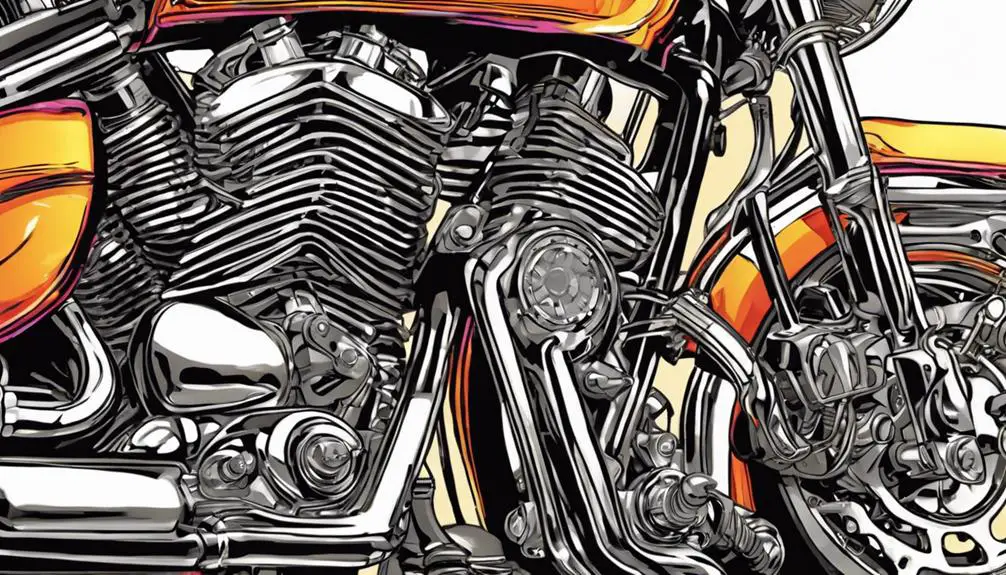
Maintaining your motorcycle's cooling system is essential for preventing overheating and guaranteeing peak performance. A well-functioning cooling system keeps your engine running smoothly, allowing you to enjoy the freedom of the open road without worries.
Here are four key tips to keep your cooling system in top shape:
- Check coolant levels regularly: Make it a habit to inspect your coolant levels. Low coolant can lead to overheating, so top it up when necessary.
- Inspect hoses for leaks: Look for cracks or leaks in your hoses. A small leak can become a big problem, leading to engine damage.
- Clean the radiator: Dirt and debris can block airflow. Clean your radiator to guarantee it can dissipate heat effectively, especially after long rides.
- Monitor temperature gauge: Keep an eye on your temperature gauge while riding. If it approaches the red zone, pull over and let your bike cool down to avoid serious engine damage.
Electrical System Checks
How often do you check your motorcycle's electrical system to verify everything's functioning properly?
Keeping your bike's electrical components in top shape isn't just about avoiding breakdowns; it's about feeling that rush of freedom when you hit the open road without a hitch.
Start with the battery. Inspect its terminals for corrosion and verify it's securely mounted. If your bike's struggling to start, it may be time for a replacement.
Next, examine the wiring. Look for any frayed or exposed wires that could cause shorts or intermittent issues. Tighten any loose connections—every little bit counts when you're chasing that sense of liberation.
Don't forget the lights! Check your headlights, taillights, and turn signals. If they're flickering or dim, replace the bulbs or check the connections. A well-lit ride not only enhances your visibility but also keeps you in control.
Routine Inspection Schedule
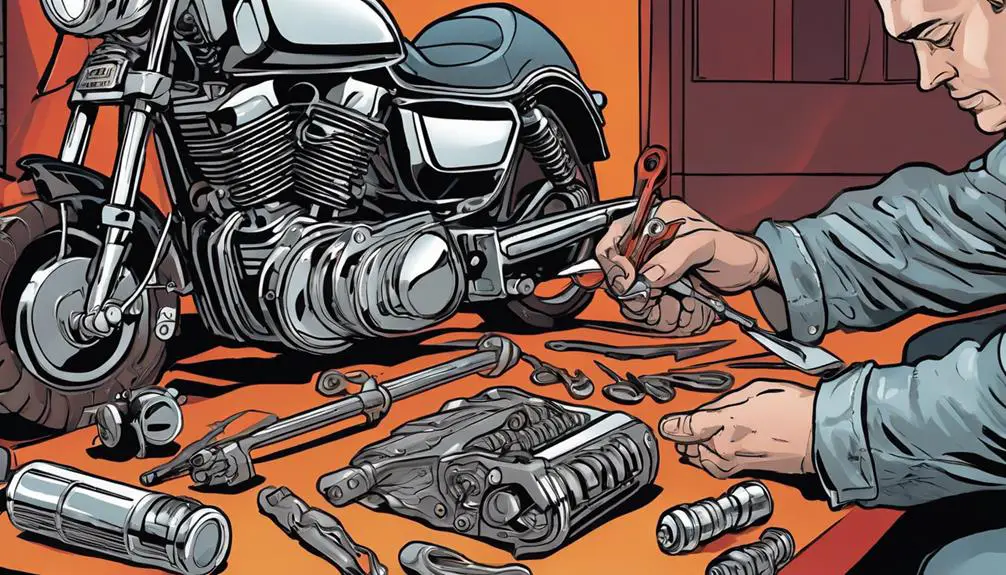
Establishing a routine inspection schedule is essential for keeping your motorcycle in peak condition and ensuring a safe ride. By committing to regular checks, you not only enhance performance but also embrace the freedom that comes with a well-maintained machine.
Here's a simple checklist to guide your inspections:
- Tires: Check tire pressure and tread depth. Properly inflated tires enhance handling and safety.
- Brakes: Inspect brake pads and fluid levels. Effective brakes are vital for stopping power, especially during those exhilarating rides.
- Oil: Regularly check oil levels and change it according to your bike's specifications. Clean oil keeps your engine running smoothly.
- Lights: Verify that all lights function properly. Visibility is key to staying safe on the open road.
Frequently Asked Questions
How Can I Tell if My Motorcycle Needs a Tune-Up?
You can tell your motorcycle needs a tune-up by noticing a few signs. If it's running rough, backfiring, or struggling to start, it's time to check in.
Pay attention to unusual sounds, decreased fuel efficiency, or if the engine light comes on. Regularly inspect the air filter and spark plugs, too.
If you're feeling off about its performance, don't hesitate to get it serviced. Your ride deserves the best!
What Should I Do if My Motorcycle Won't Start?
Picture yourself on a sunny day, ready to hit the open road, but your motorcycle won't start.
First, check the fuel; it might be time for a top-up.
Next, inspect the battery connections—loose wires can be a culprit.
If you hear clicking but nothing else, your battery might be dead. Try jump-starting it.
If all else fails, it's probably best to call a mechanic.
Don't let this hiccup hold you back!
How Often Should I Clean My Motorcycle?
You should clean your motorcycle regularly, ideally every few weeks or after every ride in harsh conditions.
Dust, dirt, and grime can build up, affecting performance and appearance.
Make it a habit to wipe down your bike after each ride and give it a thorough wash at least once a month.
This way, you'll not only keep it looking great but also guarantee it runs smoothly, enhancing your riding experience and freedom.
Can Weather Conditions Affect Motorcycle Performance?
Oh sure, ride your motorcycle like it's invincible, but weather's got other plans!
Rain might turn your ride into a slip-and-slide, while extreme heat can make your engine sizzle like bacon.
Wind? It's just nature's way of reminding you who's boss.
So, embrace those weather conditions; they're your bike's mood swings!
Keep an eye on them, and you'll keep your freedom on two wheels—smoothly cruising through whatever Mother Nature throws your way!
What Are Signs of a Failing Ignition System?
When your ignition system starts to fail, you'll notice a few key signs.
Your bike may struggle to start or stall unexpectedly, and you might hear unusual noises from the engine.
If you see a drop in power or experience rough idling, that's a red flag too.
Pay attention to flickering dashboard lights, as they can indicate electrical issues.
Catching these signs early can help you avoid bigger problems down the road.
Conclusion
By following these essential tips, you can keep your motorcycle running smoothly and enjoy countless rides.
Did you know that regular maintenance can extend your bike's lifespan by up to 50%? So, don't overlook those oil changes, tire checks, and system inspections.
Investing a little time and effort now can save you from costly repairs down the road, ensuring your adventures remain thrilling and worry-free.
Keep riding safe and stay ahead of any potential issues!